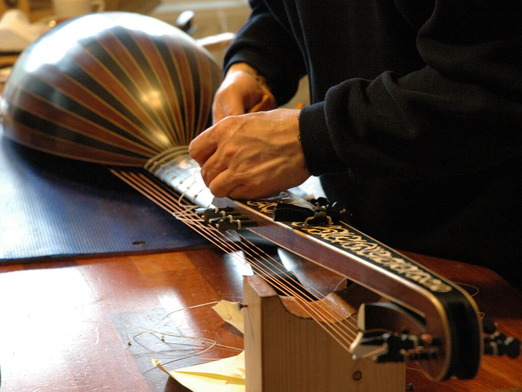In May 2015, I had the chance to attend a lecture by Renzo Salvador, specialized in the making and restoration of period plucked string instruments such as lutes, guitars, and harps. During this ‘lute afternoon’ organized by the Belgian Lute Academy in Edegem (Belgium), Renzo Salvador detailed the intricacies of his profession.
With a lute product of his craft in his hands, he explained how, in order to build the instrument, he had made use of knowledge gathered through the careful study of historical sources such as archives, treatises and surviving instruments. This historical research then informed his practice in the selection of specific types of wood, in the craft of each part’s particular shape; because each one of the instrument’s parts had a particular history that explained its shape and function:
It is very hard to transmit a lot of energy to a lute chord because it is not tense in the first place (…) So because of this, you need to build a table for the lute’s belly that is very reactive, that is, a very thin table. It has to be very light and at the same time very rigid so it can indeed catch all the energy (…) This one (knocks on the lute) is 1,3mm thick, so you see it’s very light precisely to have this type of sound. Evidently, we are not aiming for a powerful sound here, this is not the goal. The point of a lute is not to perform in front of a lot of people, it rather serves to translate the intelligence of what has been composed. It’s a medium allowing the materialization of the tablature. (Renzo Salvador, 2015)
Because my research seeks to explore the culture of early music by looking at the different ways its members understand it, what follows is a characterization of Renzo Salvador’s professional practice. Historian of science John Pickstone (2001) characterizes different ‘ways of knowing’ the world, each one characteristic of, but not exclusive to, a particular historical period. One example is the study of natural history, typical of the scientific developments of the seventeenth and eighteenth centuries.
The activity of collecting historical but also material information about each one of the different parts of an instrument in the process of building or restoring it can be associated to this particular way of knowing. To these ways of knowing the world correspond ‘ways of working’ in the world. Natural history is strongly related to medical processes such as prognosis or diagnosis. In more creative domains however, the corresponding way of working is ‘crafting’, which is central to occupations such as manufacture: But in domains concerned with creation rather than maintenance, the recognition of suitable materials, data or methods are also basic to activities we might usefully call crafting, such as cooking, dressmaking, house-building or making war. Here recipes of various kinds tell us how to combine and treat materials so as to reach defined ends (…) if we are interested in the ways in which people operate in their material world, this simple level of sorting, prescribing and concocting is enormously important (Pickstone 2011, p.237).
Renzo Salvador’s professional practice within the culture of early music can be related to the one of ‘crafting’, in which historical sources such as treatises function as recipes informing his combination of different materials into the making of a lute. However, a creative dimension inherent to both his practice and the culture he works in is added to the manufacturing process: A lute such as this one has history attached to it. I designed it by following the concepts of the time. This rosette for example has a whole story behind it. There is a reason why I carved such specific little shapes in it. But well you see, if I want to stay creative in my practice, I have to add my part of liberties to it… without committing historical mistakes! (Renzo Salvador, 2015)
This suggests that Renzo Salvador’s practice could be related to what has been coined as a ‘retroinnovation’ or “reconstruction of early musical instruments in today’s musical performance practices” (Bijsterveld & Peters, 2010). However, his explicit acknowledgement of a creative dimension in his work and its demand for taking a number of liberties question the ‘retro’ aspect of his products. In my research, I argue that an innovative dimension permeates contemporary practices of early music, questioning their ‘retro’ dimension in turn. This suggests a dynamic of transformation occurring in the culture, calling for a rethinking of its very definition, meaning and significance.
References
- Bijsterveld, K., & Peters, P. F. (2010). Composing Claims on Musical Instrument Development: A Science and Technology Studies' Contribution. Interdisciplinary Science Reviews, 35(2), 106-121.
- Pickstone, J. V. (2001). Ways of Knowing: A New History of Science, Technology, and Medicine. Chicago: University of Chicago Press.
- Pickstone, J. V. (2011). A Brief Introduction to Ways of Knowing and Ways of Working. History of Science, 49(3), 235-245.
- Lecture by Renzo Salvador, May 10, 2015, Muziekacademie Wilrijk, Edegem.


